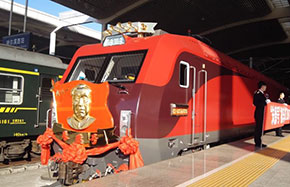Infrastructure is of the essence
Preferential policies are needed to spruce up facilities at important destinations
Though the African continent is rich in tourism attractions, tourism as an industry started evolving only in the mid-1990s. Since then it has developed and is now a pillar industry and an opportunity to escape poverty for many nations on the continent.
Seychelles is the best example of an African nation that has profited from tourism. Though it has a population of just 100,000 people, it welcomed more than 4,000 Chinese tourists last year. In other words, this indicates that Africa is fast becoming an important destination for Chinese outbound tourists.
Statistics from the World Tourism Organization show that in recent years, despite the rapid development of tourism in Africa, the continent's share in the global tourism market is still less than 5 percent. Though there is immense growth potential, a majority of the African countries lack the resources needed for developing in-depth tourist products. In other words, it is the tourism product system in Africa that needs to be improved quickly.
Tourism is not only an important source of foreign exchange for many African countries, but also an important industry in terms of new jobs. Realizing this potential, many African nations have now come out with a series of preferential policies to vigorously develop the industry.
Egypt, Morocco, South Africa, Tanzania and Kenya are all making efforts to improve their tourism infrastructure, promote tourism privatization, and increase publicity. South Africa, Kenya and Egypt have been showcasing their tourist attractions in China Central Television, CNN, BBC and other mainstream media to attract more foreign tourists.
But it is worth noting that the development of tourism industry faces many problems.
First, shortage of funds is the primary factor that is constraining African tourism and limiting the number of Chinese tourists.
This is a common challenge for most African countries. The shortage of funds is concentrated in three aspects: the relatively heavy debt burden, a very low domestic savings rate and a dwindling net inflow of external funds. This has led to limited funding in the tourism industry, and hence tourism infrastructure is far from adequate. Poor accessibility, accommodations and a host of other problems directly affect the development of tourism in Africa.
On the contrary, China's tourism industry is well developed and has established matching service facilities and well-trained service teams. Many Chinese tourists traveling in Africa have high expectations of hotels and accommodation. Africa currently has no shortage of French, English and Portuguese service personnel, but very few of the guides are fluent in Mandarin. Therefore, many Chinese tourists do not understand the stories and anecdotes behind many tourist spots.
Only a few star hotels in Benin, Congo (Brazzaville) and Ethiopia are up to international standard, while a majority of the medium and small hotels are still relatively poor in terms of facilities. Although these countries have established national hotel associations, their tourist hotel management is still backward. The World Tourism Organization's Africa 2020 Outlook report says that the improvement of tourism infrastructure, tourism products and Africa's image is the primary task.
Second, compared to China and the US, African tourism products are quite monotonous.
Currently, the African country's tourism products are mostly leisure-based traditional sightseeing. Africa has abundant tourism resources, but many unique and high-quality resources are still not being developed.
Chinese tourists adore the sun and sand there, followed by urban scenery, including museums and heritage sites; while sea cruising and forest trips are also popular. Therefore, they can exploit these advantages by developing high-end tourism products, such as sea or forest travel.
China's experiences in designing a series of tourism products, such as boutique tours, luxury tours and day trips, could be a good example. These tours can drive the development of local hotel and retail services.
Third, safety hazard is a big concern for many Chinese who plan trips to Africa.
Security is a fundamental factor affecting the choice of travel destinations. Due to historic and social reasons, civil war, unrest, terrorism, natural disasters and the spread of diseases in Africa have become constraints on the development of tourism.
Currently, even tourist powers like Kenya have an unsatisfactory security situation. Nairobi's high crime rate has posed huge problems for the safety of foreign tourists.
African criminals, especially in South Africa and Kenya, have been targeting Chinese tourists who are used to carrying a certain amount of cash and expensive cameras. Many Chinese tourists thus prefer a more secure European itinerary.
To attract international tourists and offset the adverse effects of the financial crisis, African tourism should take the initiative to team up with China and explore effective crisis response measures to improve tourist infrastructure.
China is also setting off an investment boom in Africa. Many large Chinese enterprises and private capital are eyeing opportunities from the rapid growth of tourism in Africa, such as the construction of airports, highways and high-end hotels.
African countries should seize this opportunity to attract Chinese capital, technology and high-level employees, to increase tourism infrastructure, especially public investment in services and facilities.
At the same time it should also rectify and improve tourism product planning, promote reform and innovation, improve staff training, product standardization and the overall quality of the tourism industry.
The author is a professor at the School of Tourism and Hospitality Management of Shenyang Normal University.


















